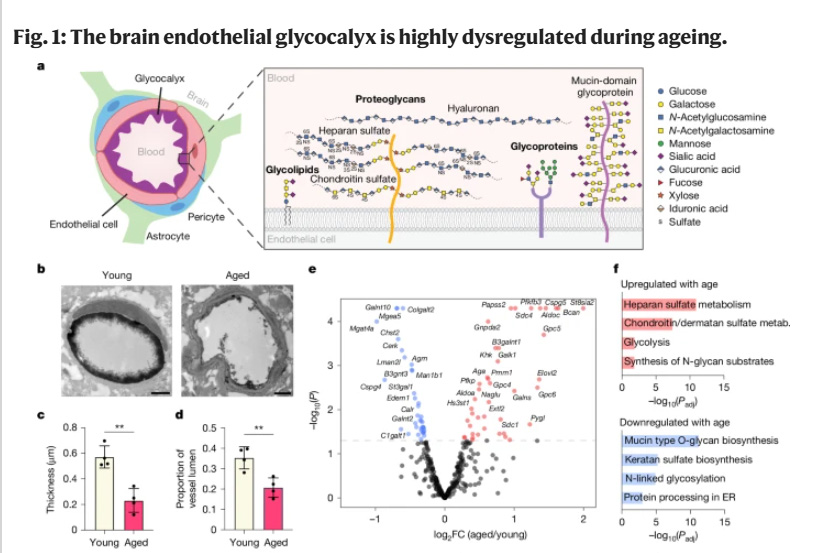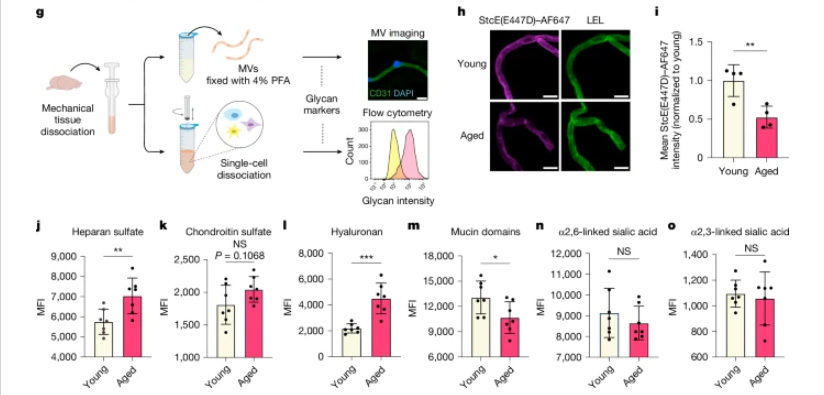Welcome to DU!
The truly grassroots left-of-center political community where regular people, not algorithms, drive the discussions and set the standards.
Join the community:
Create a free account
Support DU (and get rid of ads!):
Become a Star Member
Latest Breaking News
Editorials & Other Articles
General Discussion
The DU Lounge
All Forums
Issue Forums
Culture Forums
Alliance Forums
Region Forums
Support Forums
Help & Search
Science
Related: About this forumThe loss of sugar coating of the brain and aging.
I'll begin this post with a news item in Nature, and follow up by briefly touching on the full scientific paper.
The news item:
‘Slime’ keeps the brain safe ― and could guard against ageing
Subtitle:
Slippery proteins in the brain’s blood vessels form a protective barrier that breaks down with age, studies in mice show.
Excerpts:
A slimy barrier lining the brain’s blood vessels could hold the key to shielding the organ from the harmful effects of ageing, according to a study in mice.
The study showed that this oozy barrier deteriorates with time, potentially allowing harmful molecules into brain tissue and sparking inflammatory responses. Gene therapy to restore the barrier reduced inflammation in the brain and improved learning and memory in aged mice. The work was published today in Nature1.
The finding shines a spotlight on a cast of poorly understood molecules called mucins that coat the interior of blood vessels throughout the body and give mucus its slippery texture, says Carolyn Bertozzi, a Nobel-prizewinning chemist at Stanford University in California and a lead author of the study. “Mucins play a lot of interesting roles in the body,” she says. “But until recently, we didn’t have the tools to study them. They were invisible.”
Snotty barrier
Mucins are large proteins decorated with carbohydrates that form linkages with one another, creating a water-laden, gel-like substance. They are crucial constituents of the blood–brain barrier, a system that restricts the movement of some molecules from the blood into the brain.
Researchers have long sought ways to sneak medicines past this barrier to treat diseases of the brain. Previous work also showed that the integrity of the barrier erodes with age2, suggesting that it could be an important target for therapies to combat diseases associated with ageing, such as Alzheimer’s disease...
The study showed that this oozy barrier deteriorates with time, potentially allowing harmful molecules into brain tissue and sparking inflammatory responses. Gene therapy to restore the barrier reduced inflammation in the brain and improved learning and memory in aged mice. The work was published today in Nature1.
The finding shines a spotlight on a cast of poorly understood molecules called mucins that coat the interior of blood vessels throughout the body and give mucus its slippery texture, says Carolyn Bertozzi, a Nobel-prizewinning chemist at Stanford University in California and a lead author of the study. “Mucins play a lot of interesting roles in the body,” she says. “But until recently, we didn’t have the tools to study them. They were invisible.”
Snotty barrier
Mucins are large proteins decorated with carbohydrates that form linkages with one another, creating a water-laden, gel-like substance. They are crucial constituents of the blood–brain barrier, a system that restricts the movement of some molecules from the blood into the brain.
Researchers have long sought ways to sneak medicines past this barrier to treat diseases of the brain. Previous work also showed that the integrity of the barrier erodes with age2, suggesting that it could be an important target for therapies to combat diseases associated with ageing, such as Alzheimer’s disease...
Dr. Bertozzi won her Nobel Prize for a feature in synthetic chemistry known as "click chemistry" fast high yielding reactions, but I first became aware of her work - before she won the Nobel Prize - in connection with her lab's focus on mass spectrometry of complex sugars, including but not limited to mucins.
I had the pleasure of attending a lecture by one of Dr. Bertozzi's former postdocs, Professor Stacy Malaker, at Yale on mucins, a key component of "snot" and, as it turns out, the brain.
Here's a link to a nice paper she wrote on mass spectrometry and "mucinomics" a subdiscipline of glycomics: Mucinomics as the Next Frontier of Mass Spectrometry Valentina Rangel-Angarita and Stacy A. Malaker ACS Chemical Biology 2021 16 (10), 1866-1883
The full paper to which the news item refers is here: Shi, S.M., Suh, R.J., Shon, D.J. et al. Glycocalyx dysregulation impairs blood–brain barrier in ageing and disease. Nature (2025).
The paper is open sourced (but regrettably the news item isn't) but I'll just give a brief excerpt. BBB = blood brain barrier.
From the introduction:
The BBB forms a tightly regulated vascular interface between the blood and brain that is essential for supporting proper brain function. The highly restrictive nature of the BBB is enabled by the unique properties of brain endothelial cells, including specialized tight junctions, exceptionally low rates of fluid-phase transcytosis, and selective influx and efflux transporters1,2. The contribution of the brain endothelial glycocalyx layer to BBB function is increasingly being recognized3,4. The glycocalyx layer is a complex meshwork of glycans and glycoconjugate species (proteoglycans, glycoproteins and glycolipids) that coats the luminal surface of the BBB and, more broadly, mediates many cell surface processes including cell signalling, adhesion, transport and morphology3,5,6 (Fig. 1a). Despite forming the first barrier to entry through the BBB for any blood-derived factors, little is known about the composition and functional roles of the brain endothelial glycocalyx layer. Furthermore, BBB dysfunction, often characterized by increased vascular leakiness to neurotoxic and inflammatory circulating factors, is a key pathological hallmark in ageing and neurodegenerative diseases2,7,8,9. However, there is a lack of studies investigating the role of the glycocalyx in this process. Here we structurally and compositionally profile ageing- and disease-associated changes in the brain endothelial glycocalyx to determine how glycocalyx dysregulation in these states may contribute to BBB dysfunction...
Figure 1:


The caption:
a, Diagram of the BBB and brain endothelial glycocalyx layer. Approximations used for the relative sizing of glycocalyx components are described in the Supplementary Notes. b, TEM of cortical capillaries with lanthanum nitrate staining from young (3-month-old) and aged (21-month-old) mice. Scale bars, 1 µm. c, Quantification of luminal endothelial glycocalyx thickness of young (3-month-old) and aged (21-month-old) mice (n = 4 mice per group; two-sided t-test; mean ± s.e.m.). d, Quantification of luminal endothelial glycocalyx area of young (3-month-old) and aged (21-month-old) mice (n = 4 mice per group; two-sided t-test; mean ± s.e.m.). e, Volcano plot of differentially expressed glycosylation-related genes in brain endothelial cells from young (3-month-old) and aged (19-month-old) mice (genes upregulated with age in red and genes downregulated with age in blue). Original bulk RNA-seq data are from Yousef, et al.12. f, Top glycosylation-related pathways that are upregulated and downregulated with age in brain endothelial cells. ER, endoplasmic reticulum; metab., metabolism. g, Experimental scheme for glycan and glycoconjugate profiling of brain endothelial cells via microvessel (MV) imaging and flow cytometry. PFA, paraformaldehyde. h, Mucin-domain glycoprotein expression and Lycopersicon esculentum (tomato) lectin (LEL; endothelial marker) labelling in acutely isolated microvessels. Scale bars, 10 µm. AF647, Alexa Fluor 647. i, Quantification of h (n = 4 mice per group; two-sided t-test; mean ± s.e.m.). j–o, Median fluorescence intensity (MFI) of heparan sulfate (j; via 10E4 antibody), chondroitin sulfate (k; via CS-56 antibody), hyaluronan (l; via HABP), mucin-domain glycoproteins (m; via StcE(E447D)–AF647), α2,6-linked sialic acids (n; via SNA) and α2,3-linked sialic acids (o; via MAAII) on mechanically isolated brain endothelial cells from young (3-month-old) and aged (21-month-old) mice (n = 7 mice per group; two-sided t-test; mean ± s.e.m.). NS, not significant.
Glycomics is the new frontier in molecular biology - not new really, but has been exceedingly difficult to unravel - given because of stereochemistry for both the multiple hydroxy groups on the carbon cores of simple sugars, as well as the opportunity represented by the stereochemistry of linkages in polysaccharides. These obviously lead for huge opportunity in biochemical signaling and information.
This is important work, a product of the scientific supremacy in this country over nearly a century, now under attack by complete ignoramuses and thugs. It is an unconscionable vicious vandalism that can never be forgiven, especially as it is sure to get worse, much worse.
3 replies
 = new reply since forum marked as read
Highlight:
NoneDon't highlight anything
5 newestHighlight 5 most recent replies
= new reply since forum marked as read
Highlight:
NoneDon't highlight anything
5 newestHighlight 5 most recent replies
The loss of sugar coating of the brain and aging. (Original Post)
NNadir
Mar 1
OP
littlemissmartypants
(27,140 posts)1. Thanks so much for sharing this. ...
I'm looking forward to digging in. Neuroscience is one of my favorite topics.
Wishing you well.
❤️
![]()
littlemissmartypants
(27,140 posts)2. I found a ...
Previously archived source for the news item for you and others who may be interested.
https://www.archivebuttons.com/articles?article=https://www.nature.com/articles/d41586-025-00554-w
cachukis
(3,062 posts)3. Fascinating.